Formal family portrait photography involves capturing posed, well-composed, and carefully crafted photographs of a family or a group of individuals who are related to each other. The photograph is usually taken in a formal setting such as a studio, outdoors, or a specific location chosen by the family.
The primary goal of formal family portrait photography is to create a beautiful and timeless image that captures the essence of the family or group. It is usually characterized by careful attention to detail in terms of lighting, composition, and posing.
In a formal family portrait, the subjects are usually dressed up in their best outfits and coordinated to create a harmonious visual effect. The photographer will often give specific instructions on how to pose, where to look, and how to interact with each other.
The result is a photograph that captures the family in a polished, elegant, and professional manner. Formal family portraits are often used as gifts, wall decor, or as a way of documenting family history for future generations.
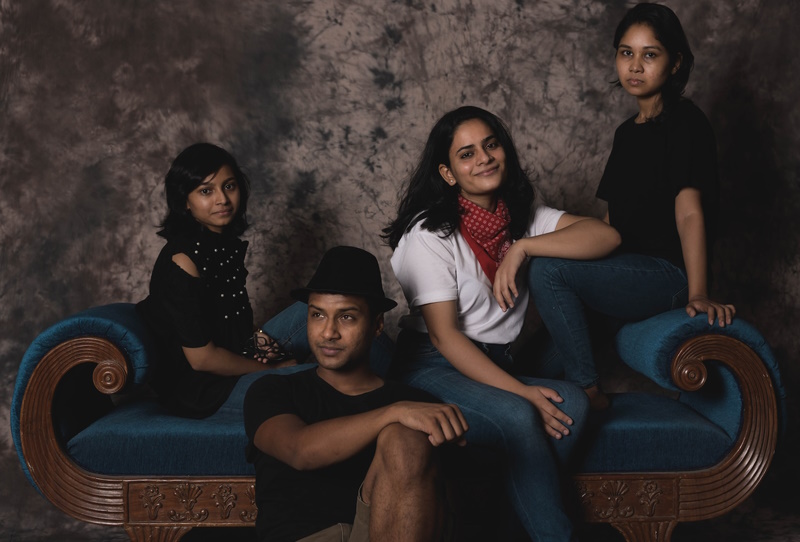
Photo by Pooja Roy on Unsplash
Table of contents
I- Introduction
-
- Why is it important to take formal family portrait photos?
- The emotional and sentimental value of family portraits
- The benefits of hiring a professional photographer for formal family portraits
- How to choose the right photographer?
II- A step-by-step Guide
-
- Plan for the Shoot
- Preparing for a Formal Family Portrait Session
- Discuss the portrait session with family members beforehand
- What to Wear for Formal Family Portraits
- Set up Your Equipment
- Posing for Formal Family Portraits
- How to pose for different family sizes (e.g. small vs large families)
- Edit the photos
- Choose the best shoots for display
- Plan for the Shoot
III- Conclusion
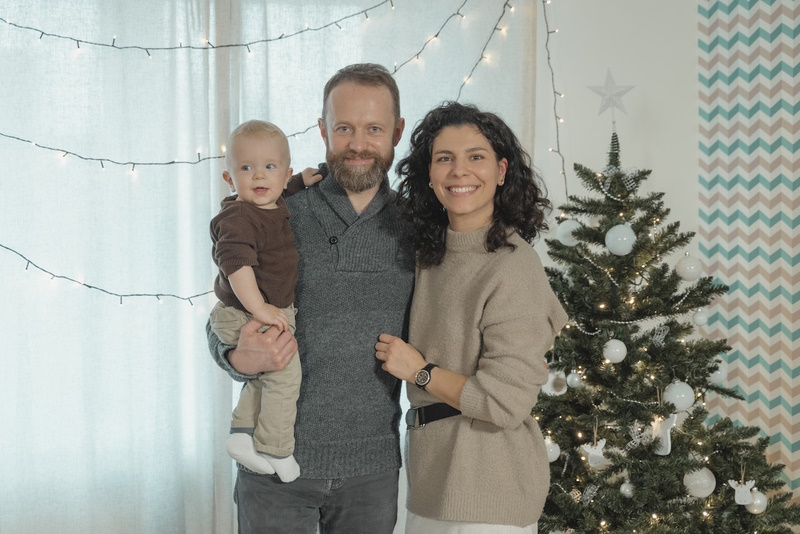
Photo by Tima Miroshnichenko
I- Introduction
1- Why is it important to take formal family portrait photos?
There are several reasons why it is important to take formal family portrait photos. Here are some of the key reasons:
-
Capturing Memories:
Formal family portrait photos capture a moment in time and can serve as a lasting memory for generations to come. These portraits serve as a tangible reminder of the people, relationships, and moments that are most important to us.
-
Celebrating Family:
A formal family portrait is a way to celebrate and honor the relationships within a family. It provides an opportunity to come together, dress up, and document the bonds that tie us together.
-
Creating Heirlooms:
A formal family portrait can become an heirloom that is passed down through generations. It is a way to document family history and serve as a visual record of the family’s growth and evolution over time.
-
Professional Quality:
Formal family portrait photography is typically done by a professional photographer who has the expertise and equipment to create high-quality images that are well-composed and well-lit. This ensures that the portrait will look its best and be a cherished keepsake for years to come.
-
Building Self-Esteem:
Formal family portraits can help build self-esteem and confidence, especially in children. When a family takes the time to come together, dress up, and take a formal portrait, it sends a message of unity and pride in the family that can boost self-esteem and confidence in family members.
2- The emotional and sentimental value of family portraits
Family portraits are often treasured for their emotional and sentimental value. They capture the essence of the family and the relationships between family members. Looking at a family portrait can bring back memories of shared experiences, special moments, and even loved ones who are no longer with us. Family portraits can evoke feelings of joy, love, and nostalgia, making them an important part of family history and heritage.
3- The benefits of hiring a professional photographer for formal family portraits
Hiring a professional photographer for formal family portraits has several benefits. Professional photographers have the expertise and equipment to create high-quality images that are well-lit, well-composed, and visually appealing.
They can help guide family members through the posing process, making sure everyone looks their best. A professional photographer can also help with editing and retouching to ensure the final product is of the highest quality.
Finally, hiring a professional photographer takes the pressure off family members to capture the perfect shot themselves, allowing them to relax and enjoy the experience of being together.

Photo by Werner Pfennig
4- How to choose the right photographer
Choosing the right photographer for formal family photography is an important decision, as the photographs will capture precious memories that you’ll want to cherish for years to come. Here are some factors to consider when selecting a photographer:
- Style: Look for a photographer whose style aligns with your preferences. Do you want a more traditional or contemporary style? Do you prefer posed or candid shots? Check out the photographer’s portfolio to see if their style matches what you’re looking for.
- Experience: It’s important to choose a photographer with experience in family photography. You want someone who knows how to pose groups and make everyone look their best. Ask to see samples of their previous family photography work.
- Communication: Communication is key when working with a photographer. You want someone who listens to your needs, communicates clearly, and is responsive to your questions and concerns.
- Price: Consider your budget when selecting a photographer. While you don’t want to skimp on quality, you also don’t want to overspend. Get quotes from several photographers and compare their prices and packages.
- Reviews: Check out the photographer’s reviews from previous clients. This can give you an idea of the quality of their work and their level of customer service.
- Personality: You want a photographer who is easy to work with and makes everyone feel comfortable. Look for someone who is friendly, personable, and professional.
By considering the below factors, you can choose a photographer who will capture your family’s memories in a way that you’ll cherish for years to come.
For further reading check my post “5 Tips To Pick A Photographer”
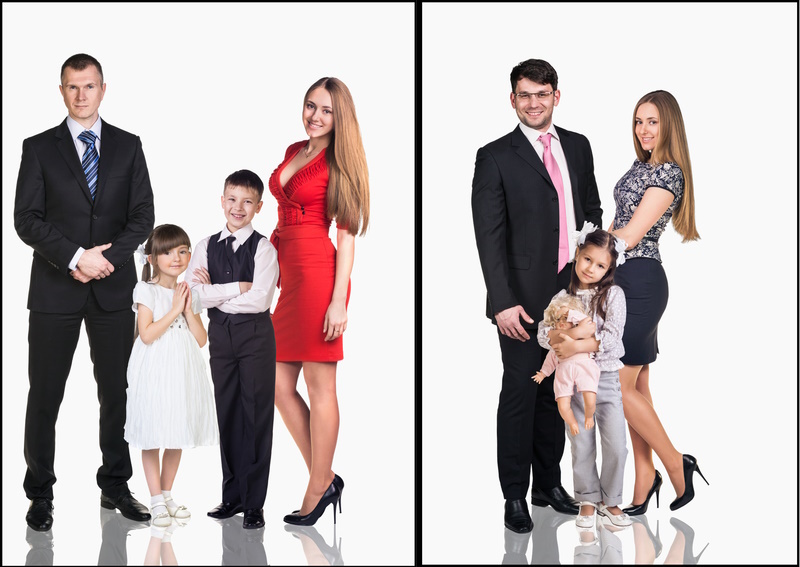
Photo by Depositphotos
II- A step-by-step Guide
1- Plan for the Shoot
1-1- Make a Plan and prepare for the photo session
Planning and preparation are very important when it comes to a formal family portrait session. Below are some reasons, you have to consider before committing to a family session:
- Timing: Planning ahead will allow you to schedule the session at a time that works for everyone. This is especially important if you have family members who live far away or have busy schedules.
- Location: Choosing the right location for the portrait session is important. You want a location that is both visually appealing and convenient for your family. Planning ahead will give you time to scout out potential locations and choose the best one.
- Wardrobe: Deciding what to wear can be a daunting task, especially when it comes to coordinating outfits for multiple people. Planning ahead will give you time to choose outfits that complement each other and fit the style of the portrait.
- Props: If you plan on incorporating props into your portrait session, you’ll want to have them ready ahead of time. Planning ahead will give you time to gather any necessary props and ensure they are in good condition.
- Hair and Makeup: If you plan on having professional hair and makeup done, it’s important to schedule appointments well in advance. This will ensure that everyone looks their best on the day of the portrait session.
- Photographer: Booking a photographer ahead of time will ensure that you have enough time to find the right photographer for your family. It will also give the photographer time to prepare for the session and ensure that they have all the necessary equipment.
In summary, planning, and preparation are essential when it comes to a formal family portrait session. It will help you to schedule the session at a time that works for everyone, choose the right location, coordinate outfits, gather props, schedule hair, and makeup appointments, and find the right photographer. By taking the time to plan ahead, you’ll be able to ensure that your family’s portrait session goes smoothly and results in beautiful, timeless photographs.
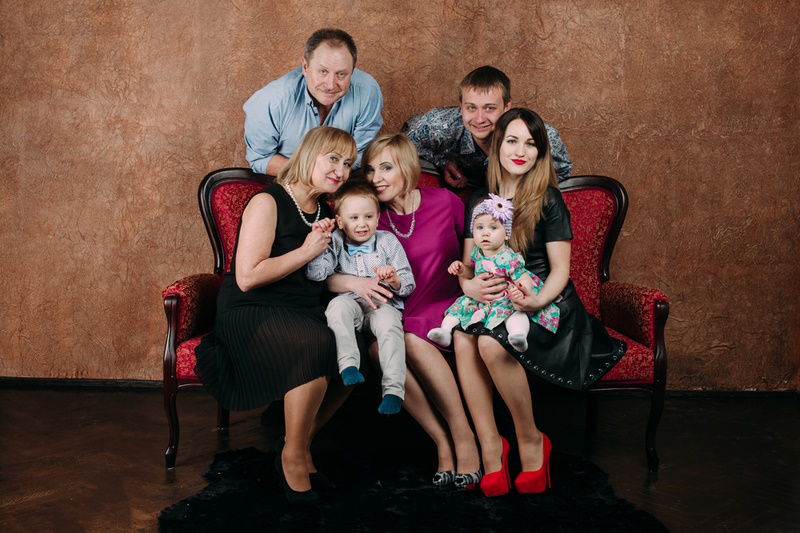
Photo by Depositphotos
1-2- Discus the portrait session with family members beforehand
Discussing the portrait session with family members beforehand is an important step in ensuring a successful and enjoyable experience. Here are some reasons why:
- Set expectations: By discussing the portrait session with family members, you can set expectations for what will happen during the session. This can help to alleviate any anxiety or uncertainty and ensure that everyone is on the same page.
- Coordinate schedules: By discussing the portrait session ahead of time, you can coordinate schedules and ensure that everyone is available at the same time. This is especially important if you have family members who live far away or have busy schedules.
- Choose wardrobe: Discussing the portrait session ahead of time can also help you to coordinate outfits and choose the right wardrobe for everyone. This can ensure that everyone looks their best and that the overall look of the portrait is cohesive.
- Plan logistics: By discussing the portrait session beforehand, you can also plan logistics such as transportation, parking, and any necessary props. This can help to ensure that everything runs smoothly on the day of the session.
- Address concerns: Discussing the portrait session with family members can also provide an opportunity for anyone to voice any concerns or ask questions. This can help to ensure that everyone is comfortable and relaxed during the session.
In conclusion, discussing the portrait session with family members beforehand can help to set expectations, coordinate schedules, choose a wardrobe, plan logistics, and address any concerns. By taking the time to communicate with everyone ahead of time, you can help to ensure that the portrait session goes smoothly and results in beautiful, timeless photographs.
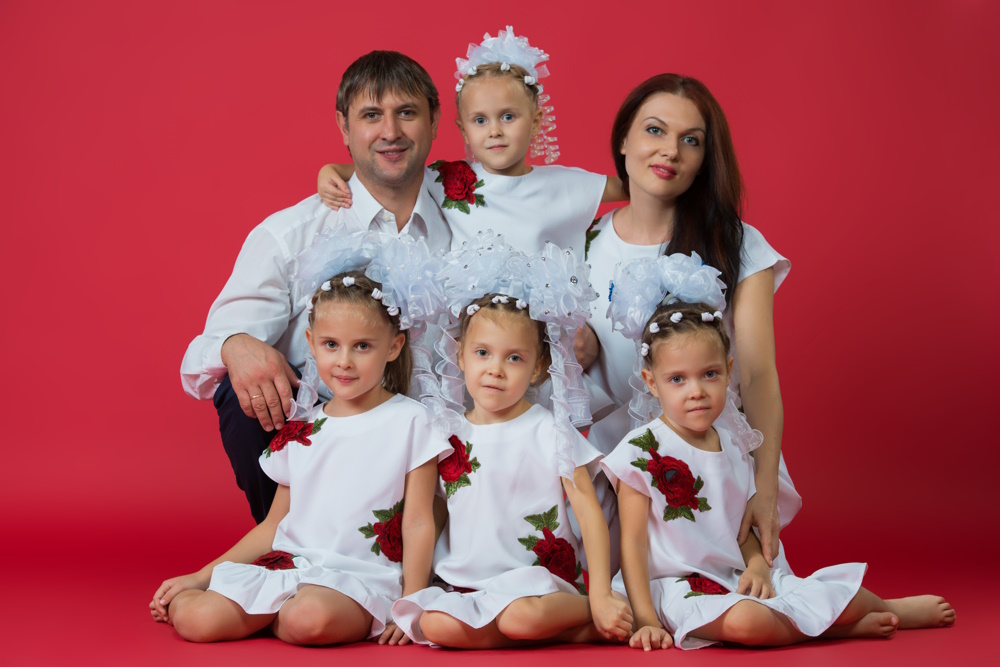
Photo by Depositphotos
1-3- What to Wear for Formal Family Portraits
It is important to put some thought into what to wear. The clothing choices can have a big impact on the overall look and feel of the photos. Here are some tips for selecting outfits:
- Consider the location and setting of the photo shoot: If the portraits will be taken in a formal setting, such as a studio or a fancy hotel lobby, you may want to dress more formally. If the photos will be taken outdoors, consider the weather and choose appropriate clothing.
- Coordinate colors and styles: It is a good idea to choose a color palette and have everyone wear colors that complement each other. You don’t need to have everyone match exactly, but it is important that the colors look good together. For example, if one person is wearing a bright red shirt, others can wear more neutral colors like black, white, or navy.
- Avoid clothing with logos or graphics: These can be distracting and take away from the focus of the photo, which should be your family.
- Dress for the occasion: If the portraits are for a holiday card, you may want to dress in festive clothing. If the portraits are for a more formal occasion, such as a wedding, you may want to dress in more formal attire.
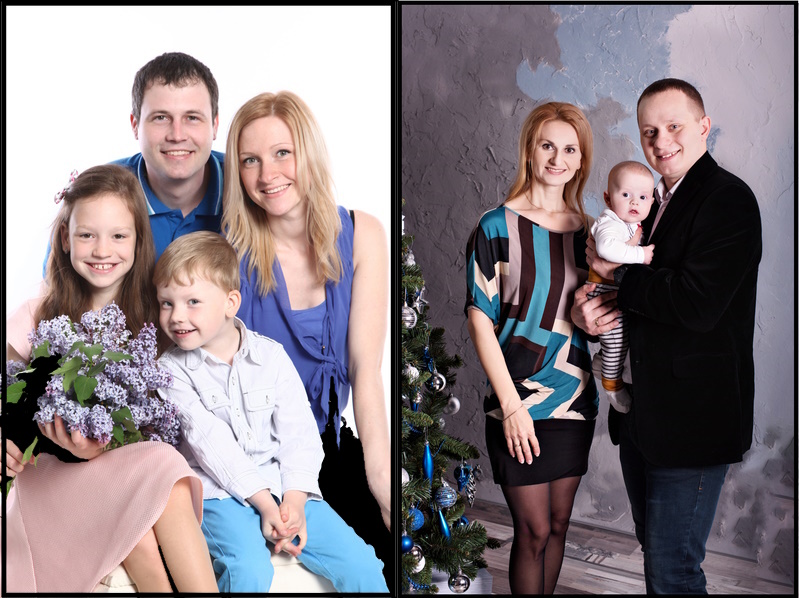
Photo by Depositphotos
2- Set up Your Equipment
Setting up your equipment for a formal family portrait requires careful planning and attention to detail. By following the below steps, you can ensure that you have all the necessary equipment to capture the perfect shot. Remember to test your equipment before the shoot to make sure everything is working properly.
- Camera & lenses
Start by selecting the appropriate camera for the job. A DSLR camera or a mirrorless are good choices as they allow you to change lenses and adjust settings to get the perfect shot. Choose a lens that is appropriate for the location and the style of the shoot. For example, a wide-angle lens is ideal for capturing the entire family in a small room, while a telephoto lens is better for outdoor shoots where you need to zoom in on your subjects.
- Tripod
A tripod is essential for keeping your camera steady and preventing camera shaking. This is especially important when shooting with slow shutter speeds or in low light conditions. Choose a sturdy tripod that can support the weight of your camera and lens.
- Remote Trigger
Using a remote trigger can help you take the shot without touching the camera and risking the camera shake. This is especially useful when shooting in low light conditions or with slow shutter speeds. You can use a wireless or wired remote trigger depending on your camera model.
- Lighting Equipment
If you’re shooting indoors, you’ll need to use artificial lighting to illuminate the scene. A softbox or umbrella is ideal for creating soft, even lighting that illuminates everyone’s face. Position the lighting equipment at a suitable distance from the family members and adjust the intensity and direction of the light as needed.
- Backdrop
If you’re shooting indoors, you may want to use a backdrop to create a more formal setting. A plain white or black backdrop is a classic choice, but you can also choose a colored or patterned backdrop that complements the family’s clothing or the location.
- Memory Card and Batteries
Make sure you have plenty of memory cards and batteries on hand. Shooting a family portrait can take a lot of time, so make sure you have enough battery power to last through the shoot. It’s also a good idea to have spare memory cards on hand in case you run out of space on your primary card.
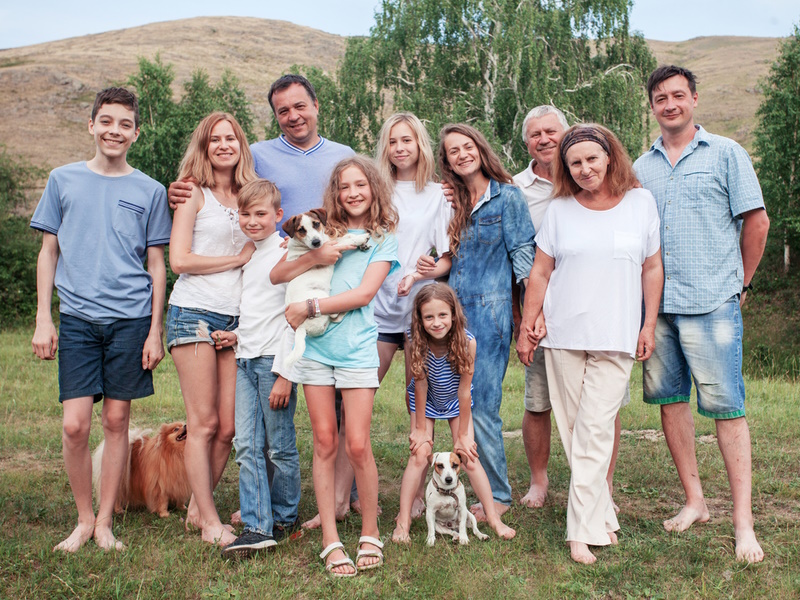
Photo by Depositphotos
3- Posing for Formal Family Portraits
Posing for a formal family portrait can be intimidating, but with a few tips, you can make the process much easier. Here are some things to keep in mind:
- Stand up straight: Good posture is key to looking your best in a family portrait. Stand up straight and avoid slouching or leaning to one side.
- Angle your body: Turn your body slightly to one side instead of facing the camera head-on. This creates a more flattering silhouette and can help to make you look slimmer.
- Place your arms: Don’t let your arms hang awkwardly by your sides. Place your arms naturally on your hips, behind your back, or hold onto something like a prop.
- Keep your chin up: Avoid tilting your head down or looking down at the ground. Instead, keep your chin up and look straight ahead at the camera.
- Smile naturally: The key to a great smile is to keep it natural. Avoid forcing a smile or grinning too widely. Think of something happy or funny to help you relax and smile naturally.
- Get close: Don’t be afraid to get close to your family members in the photo. This can create a sense of intimacy and connection in the portrait.
- Use props: Props can add interest and personality to your family portrait. Consider using a family heirloom, a flower bouquet, or something else that has special meaning to your family.
Remember, a formal family portrait should be a reflection of your family’s personality and style. So, don’t be afraid to experiment with different poses and ideas to create a portrait that you will cherish for years to come.
For further reading, check my post “Portrait Photography Poses- How To Pose At A Photo Shoot”
4- How to pose for different family sizes (e.g. small vs large families)
Posing for a family portrait can be challenging, especially when you have different family sizes to work with. Here are some tips on how to pose for different family sizes:
-
Small families (2-4 people):
- Stand close together: Use the space wisely and stand close to each other to create an intimate and connected portrait.
- Use the rule of thirds: Avoid centering the family in the photo, instead, place the family off to one side of the frame to make the photo more visually interesting.
- Embrace asymmetry: Don’t be afraid to experiment with posing at different angles and levels to create a dynamic and visually interesting composition.
-
Medium-sized families (5-8 people):
- Create layers: Use different heights and positions to create visual depth in the photo. Have some family members stand, others sit, and others kneel to create visual interest.
- Use props: Incorporating props like a bench, a stool, or a tree can help to create a more interesting composition.
- Consider diagonals: Try placing family members in diagonal lines to create a more dynamic composition.
-
Large families (9 or more people):
- Use groups: Consider breaking the family into smaller groups and arranging them in layers to create depth and visual interest.
- Arrange in a triangle shape: Arrange family members in a triangle shape to create a cohesive and visually pleasing composition.
- Consider the location: Use the environment and location creatively to create an interesting composition. For example, some family members stand on a higher level, while others stand on a lower level.

Photo by Depositphotos
5- Edit the Photos
Editing and retouching family portrait photos can play an important role in creating a polished and professional final product. Here are some reasons why editing and retouching are important:
- Enhancing colors and exposure: Even the best family portrait photos can benefit from some basic color and exposure adjustments. Editing can help to enhance the colors in the photo, making them more vibrant and true to life. Adjusting the exposure can also help to bring out the details in the photo, especially if it was taken in low light conditions.
- Removing distractions: Sometimes, there are distracting elements in the photo that takes away from the focus of the family. This could be something as simple as a stray hair or a piece of lint on clothing. Retouching can help to remove these distractions and create a cleaner, more polished image.
- Fixing imperfections: Nobody is perfect, and there may be imperfections that you want to remove from the photo. For example, you may want to remove a blemish or reduce the appearance of wrinkles. Retouching can help to create a more polished and flawless look.
- Creating a consistent look: If you are creating a series of family portrait photos, editing, and retouching can help to create a consistent look across all of the photos. This can make them look more cohesive and professional when displayed together.
- Preserving memories: Family portraits are often cherished keepsakes that are passed down from generation to generation. By editing and retouching the photos, you can ensure that they look their best and are preserved for years to come.
6- Choose the best shoots for display
Choosing the best formal family portrait for display can be a difficult decision, however here are some tips to help you choose the perfect one:
- Consider the occasion: Think about the purpose of the photo and where it will be displayed. Is it for a special event, such as a wedding or anniversary? Will it be displayed in a formal living room or a more casual space?
- Think about composition: Look for a photo with a strong composition that is visually pleasing. Consider factors such as symmetry, balance, and visual flow. Also, consider the placement of family members in the photo and how they interact with each other.
- Look for emotional resonance: Choose a photo that captures the personality and emotions of your family. The best photos are the ones that evoke strong emotions and memories.
- Get feedback: If you’re having trouble deciding on a photo, ask for feedback from family members or a professional photographer. They may have insights and suggestions that can help you make the best decision.
For further reading check the post “How to Use AI to Cull Photos?”

Photo by Misho chachanidze
III- Conclusion
Shooting a formal family portrait can be a bit challenging as it involves coordinating and posing multiple individuals. In order to recap the article here’s a brief step-by-step guide on how to shoot a formal family portrait photograph:
- Step 1: Plan the Shoot
Firstly, you need to plan the shoot by discussing with the family members about their preferences and expectations for the shoot. Ask them about the location, clothing, and any props they want to include. Decide on a suitable location for the shoot, whether it be indoors or outdoors.
- Step 2: Set Up Your Equipment
Set up your camera, tripod, and lighting equipment. If you’re shooting indoors, make sure you have sufficient lighting to illuminate the scene. Also, set up a backdrop if necessary.
- Step 3: Adjust the Lighting
Adjust the lighting to ensure that everyone’s faces are well-lit and visible. Use a reflector or flash to eliminate any shadows or dark spots.
- Step 4: Pose the Family
Once everyone is dressed and ready to go, start by posing the family members in a comfortable and natural way. Begin by positioning the tallest member in the center of the group and placing the rest of the members around him/her. Make sure everyone can be seen clearly in the frame.
- Step 5: Review the Shots & Edit
Review the shots and select the best ones. Check for any mistakes, such as blurring, overexposure, or underexposure. You can also use photo editing software to touch up the images if necessary.
Related posts
Creative Family Photoshoot Ideas
What To Wear To A Family Photoshoot
Low Key Portrait Photography – Create A Dramatic Family Composite Photo!
Family Portrait Photography Tips – 5 Tips For Great Portraits
Thanks for reading, I hope you enjoyed the article, in case you have any questions just drop them below & I will be happy to answer you.
The featured Photo by Depositphotos
If you enjoy the site, don’t forget to subscribe, we will only inform you when a new article is posted.





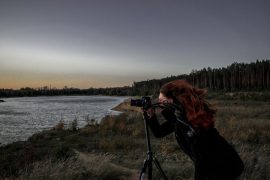



Thank you for your detailed sharing.
My husband is currently learning portrait photography, as well as photo editing software such as Photoshop.
Compared with shooting objects, he prefers to shoot people, because people can record more profound time.
This is a very good teaching article for him.
hope you can continue to share photography-related articles, and I will keep following ~
Thank you for your kind words and feedback on the article! I’m glad to hear that it was helpful for your husband’s portrait photography and photo editing pursuits. Shooting people can certainly create more emotional and meaningful images compared to objects, as you mentioned.
I’m always happy to share my knowledge and experiences in photography, so I will definitely consider writing more photography-related articles in the future. Thank you for following and supporting my work, and best of luck to your husband in his photography journey!
I have been going through nearly fifty years of photographs in preparation for a big move and downsizing at the same time. Not only has it taken me down memory lane and reminiscing about the funtimes, but it has made me realise how important it is to take photographs. It captures the moment to create special memories.
This step-by-step guide is very helpful for those wanting to prepare for a family photo shoot. Do you think that by using a tripod the family can do the shoot themselves? Or is it better for these formal family photographs to use a professional photographer?
Thank you for sharing your personal experience with going through old photographs. It’s true that looking back on memories can be a very sentimental and reflective experience, and photography is a wonderful way to capture those moments and create lasting memories.
Regarding your question about using a tripod for a family photo shoot, it is certainly possible for a family to do the shoot themselves with the help of a tripod. However, there are several factors to consider before deciding whether to use a professional photographer or DIY approach. A professional photographer can bring expertise, experience, and specialized equipment to the shoot, which can result in higher quality and more polished images. Additionally, a professional can guide the family through the shoot, help with posing and lighting, and make the process smoother and more efficient.
On the other hand, if a family has a good understanding of photography, has the necessary equipment, and is comfortable with taking and editing their own photos, then using a tripod and doing the shoot themselves can be a viable option.
Ultimately, the decision will depend on the family’s budget, goals, and preferences. Whatever option is chosen, the important thing is to have fun and create lasting memories!